by Sarah Segall | Mar 26, 2016 | In The Loop
Language Arts / artes del lenguaje
What a busy week! We spent a lot of time working on science, although we had time to work on our literacy routines: spelling(dictado), word work, grammar, listening comprehension and independent reading time. Students took home a new book this week. Please make sure your child continues to practice their reading in Spanish on a daily basis.
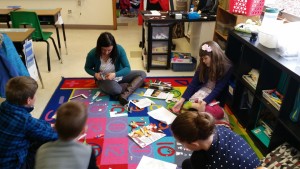 Our theme this week was Las flores, and thanks to Connor and his beautiful family, the ending of the week could have not been more perfect. Thank you!. Please make sure you stop by and see our beautiful bulletin board. Students worked really hard on the spelling and vocabulary project of the song Las flores. Also, in connection to math (lines, segments, angles, triangles, etc.), students created wonderful art pieces!
Our theme this week was Las flores, and thanks to Connor and his beautiful family, the ending of the week could have not been more perfect. Thank you!. Please make sure you stop by and see our beautiful bulletin board. Students worked really hard on the spelling and vocabulary project of the song Las flores. Also, in connection to math (lines, segments, angles, triangles, etc.), students created wonderful art pieces!
We also had a small preview of our new literacy unit, Going West. We had a chance to preview vocabulary and do a listening comprehension activity of the story La caza del bufalo. We will be working on this story and digging into our new unit next week!
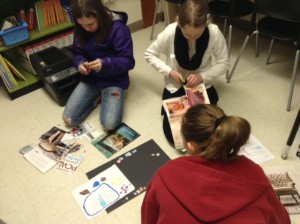 Science / ciencia
Science / ciencia
During science this week:
Research Project – Based on the science investigations covered during our Environments module this term, students choose an area of study , formulate a question and plan an investigation to answer it. Students selected a topic from our winter science module, Environments, to investigate in greater depth. The results of their project will be shared with the rest of the class in a formal presentation next week. On Monday, students were given a rubric, a calendar, a book and possible ideas for their research projects. They are welcome to come up with their own as well. Most of the work will be done at home, however, we will spend the first part of next week working on this project in class. Students are encouraged to come to class prepared to conduct independent research. Presentations will have a duration of 3 to 4 minutes and will take place on March 31st. Please make sure your child completes their obligations on a timely manner.
Investigation 5: Salt of the Earth
What is the salt tolerance of several common farm crops? To find the answer to this question students set up a controlled experiment to test the effect of salinity of four kinds of plants. They planted four containers with identical arrays of seeds: barley, corn, peas, and radishes. They watered each container with a different concentration of salt water. In order to make sense of this investigations students needed to apply the concepts/objectives learned through our units:
- Environment is everything that surrounds and influences an organism.
- An environmental factor is one part of an environment. It can be living and non-living.
- Optimum is the condition or degree of an environmental factor that is most favorable to growth, development, and reproduction of an organism.
- Organism have ranges of tolerance for environmental factors.
Our aquatic environments investigation has come to an end. Your child is allowed to take their fish home. If they are authorized by a parent, bring a container on Monday so they can bring their fish home.
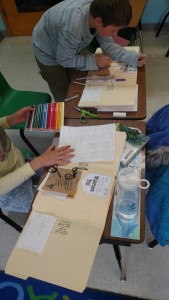 History & Geography
History & Geography
In history and geography we started our lapbooks about ” The Westward Expansion before the Civil War”. We began by learning about Daniel Boone and his contributions to Westward expansion. In our lapbooks we traced the U.S., made a wilderness journal, made a vocabulary pocket, and added a wilderness trail patch. In our Wilderness journal we were able to add our first entry, which was a letter written from the perspective of Daniel Boone. We pretended that Daniel Boone explored the land that Spanish With Sarah is built on. The students were given a lot of free creativity to decide the time period when Daniel Boone is exploring as well as who the letter is addressed too. Ms. Ivary read us a book about Daniel Boone and Westward Expansion, and that’s where we found our vocabulary words.We also had a quick vocabulary quiz at the end of the week, ask your student to define or use any of our vocabulary words in a sentence. We have had so much fun!
Vocabulary Words: blaze, commerce, frontier, Wilderness Trail, Cumberland Gap
Written/Edited by Riley and Bailey in collaboration with Ms. Ivary
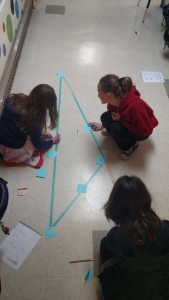 Math
Math
This week we focused on finding the area, the base, and height of a triangle. We began with in class discussion about what we already knew about triangles. We went over the rules of finding the area of a triangle. Ask your student what they are! We went out to the hall and did a fun activity with triangles. We had to find the area, base, vertex and height of the large triangles, you may have seen them in the hallway this week. We presented our findings for the triangles to each other in preparation for our area of a triangle test. On Friday we had our area of a triangle test and we will continue to work with angles next week. We went over our corrected homework about finding the height of a triangle. We will begin correcting our own math homework so that we can correct any mistakes and clarify any confusing points. We had a very FUN week!!!
Written/Edited by Riley and Bailey in collaboration with Ms. Ivary
English Spelling/ Vocabulary
This week for spelling we played BAM!. Because this was a review week for spelling, all 5 spelling lists were thrown into a bag. Then one-by-one we pulled out a word and had a classmate read us the word, if we were correctly able to spell the word we kept the card. The student with the most cards at the end of the month will win a prize! If we pulled a SWIPE card we were able to swipe a card from another student as long as we can spell the word on the card. If we pulled a BAM! card we had to pull a card from the BAM! bag and spell it. Words in the BAM! bag are from the next unit and so the students have not worked with them yet. If they could spell the word correctly they could keep both the BAM! card and the word card giving them double points! If not they must return all their cards to the bag. We will also have a quick 10 word spelling quiz on Monday, the quiz can have any of the words from the 5 lists on the review packet. In vocabulary this week we made little flash cards that go in our Vocabulary pocket in our Westward Expansion Lapbooks. On each flashcard we were able to choose whether to write the exact definition, an example sentence, or a drawing; which ever helped us remember the definition of the word the best.
Written/Edited by Madi in collaboration with Ms. Ivary
Art
The 4th and 5th graders continued working on their paintedpaper landscape collages. They cut out shapes from their painted papers and pieced them together to make very colorful, textured landscapes. We’ll finish up this project next week.
Music
Cowboy songs were this week’s topic. We listened to YouTube versions of The William Tell Overture (Lone Ranger), “Back in the Saddle Again,” (Gene Autry) and “Happy Trails” (Roy Rogers and Dale Evans) and learned “Git Along, Little Doggies” and “The Old Chisholm Trail.
by Sarah Segall | Mar 26, 2016 | In The Loop
Language Arts
What a busy week! We started our new unit En equipo / On a team. This unit is all about working together in groups or teams to make things easier. The students really enjoyed sharing about the teams they have participated in. Next week we will work on a large mural together to show how teamwork really helps get things accomplished.
Many hands makes for light work.
Writing: Students wrote in their journals about the teams they have participated on. Students also wrote a few sentences about the drawing they did last week. We went through the editing process, individually, and then the students re-wrote their writing piece. We ‘published’ these and have hung them in the classroom. This was our first time through the entire writing process.
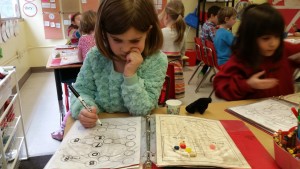 Math
Math
We changed a few pages in our morning binders. Now we are using our number of the day to complete questions about the place value and how to represent the number in cubes, coins, and words. We also have a pattern of the day section where we will practice counting on, counting by 2’s, 5’s, 10’s, and counting backwards from random numbers. We have worked with number bonds throughout the year but have now added a daily practice section to our morning binders. These really help solidify number families and part-whole relationships. We used jelly beans on Friday to decompose the number 8 in our number bonds.
We worked on comparing weights of objects this week. pesado = heavy liviana = light.
We also began an activity that is typically a favorite of all kindergarteners. Estimation!! I put stacked three 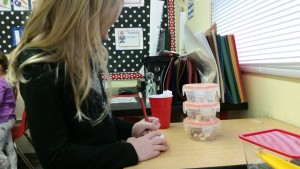 containers and put 10 items in the top container, an unknown number of items in the middle container, and 100 items in the bottom container. The students then had to estimate the unknown numbers of items. This is called scaffolding estimation, allowing the students to use quantities of greater and less than to help guide them in their estimation.
containers and put 10 items in the top container, an unknown number of items in the middle container, and 100 items in the bottom container. The students then had to estimate the unknown numbers of items. This is called scaffolding estimation, allowing the students to use quantities of greater and less than to help guide them in their estimation.
We will continue to have daily estimations for the remainder of the school year. It is always very fun for the students to bring special treats or items to use in the estimation jars. Please feel free to send in something for us to use. I will just collect any items sent in and use them as needed. Please remember to send in only items that are the same size. Some suggestions would be, small snacks, jelly beans, beads, legos, coins, skittles, marbles, game pieces, pebbles, hair ties, gum balls, etc. We do have gluten, dairy and egg allergies in our class but will plan to provide an alternative snack for allergy kiddos (like myself) if foods are sent in for estimation.
Science
This week we continued our farm unit. The kids are enjoy learning about the animals raised on farms and their uses. We learned about pigs and sheep this week. See if your child can tell you some of the reasons farmers raise pigs and sheep. We learned about the lifecycle of a chicken and made a diagram on an egg. You can see these hanging in the hall. Have your child explain the steps. We are also working on individual farm books.
We read the Little Red Hen and did a retell activity. Retell is a great way to work on comprehension and sequencing.
History & Geography
Throughout the year we have learned about each continent: the food, animals, plants, people, weather, geography, holidays, tourist attractions, etc. My family has had the privilege to host two Japanese exchange students this week and the students got to meet Osawa and Haruka. We learned about Japan/Asia this week.
 Art
Art
The Kindergarteners learned how to draw a sheep this week, to complete our unit on March weather. (We’re still hoping that March will go out like a lamb!). The students used basic shapes to draw a sheep, using crayon, and then they used corks dipped in white tempera to create the wooly texture. These turned out so cute! Happy Spring!
Music
This week we learned (with blackboard illustrations) the progressive song, “Estaba la rana cantando debajo del agua.” We also watched YouTube videos of selections from “The King and I.”
by Sarah Segall | Mar 26, 2016 | In The Loop
Language Arts
What a busy week! We read a new story about young entrepreneurs who have been successfully working at things they love at very young ages.
We learned all about writing formal letters. We read a book, Un policia bilingüe, about a funny bilingual police officer and decided to write a formal letter to his captain. We learned all about headings, salutations, the body of the letter, closing, and signature. During this process we realized many students do not know their address. We talked about why this is important (safety!!). Please work on this!
Students are in the final stage of the writing process for their realistic fiction piece. They have their final draft and their little book. They can work on their illustrations and neatly copying their work. They’ve been very excited about this process and I’m looking forward to putting these in the hallway for everyone to enjoy.
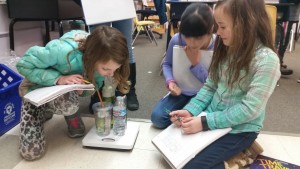
Using different scales to measure weights.
Math
We reviewed all their prior knowledge of length, weight, and capacity. During this new unit students are building on these concepts and learning to measure using customary units. We really enjoyed our hands-on measurement activities and comparisons. Exploring capacity was especially fun! Our objectives this week were to:
- use inch, foot, yard, and mile as units of measurement for lengths.
- estimate and measure given lengths.
- use referents to estimate lengths.
- use ounce, pound, and ton as units of measurement for weight.
- measure capacity with cup, pint, quart, and gallon
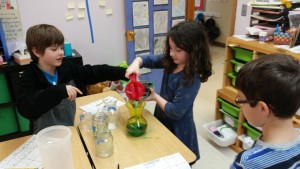
Estimating capacity and then measuring to determine accuracy.
inch (in.) – pulgada (pulg)
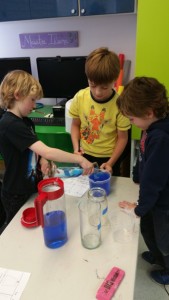
Comparing capacity of different shaped containers.
half-inch – media pulgada
foot (ft) – pie (ft)
yard (yd) – yarda (yd)
mile (mi) – milla (mi)
ounce (oz) – onza (oz)
pound (lb) – libra (lb)
ton (T) – tonelada (T)
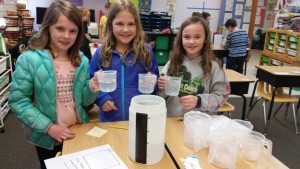
Exploration of equivalent measurements. (16 cups = 8 pints = 4 quarts = 1 gallon)
cup (c) – taza (tz)
pint (pt) – pinta (pt)
quart (qt) – cuarto (ct)
gallong (gal) – galon (gal)
History & Geography
This week we began our new unit on European exploration. We started with a lesson on Columbus in 1492. We reviewed what the class already knew about Columbus and made predictions about what we would be hearing in our readings. We read about the Conquistadors and how Columbus’s second voyage was, in many ways, more important than the first. We had several interesting discussions about the negative impact on the inhabitants of the islands that were visited in these voyages. We listened to the song “1492” and then began practicing it. The class loves singing this song! Students began their European Explorers’ travel log and wrote an entry on Columbus. We also finished our Children Of The Longhouse chapter book this week. Everyone loved this book!
Science
We learned about Mae Jemison in science this week. She is an incredible woman and the class was so impressed with her accomplishments in her life. We continued to work on our Nicolaus Copernicus biography but I gave the class the option of doing a biography on Jemison instead if they wanted to. About half the class chose to write one on Mae Jemison, even though that meant more work on their part since they were partially done with their biography on Nicolaus Copernicus. I am pleased though, because I think this will lead to some interesting comparison discussions about these two amazing people. The journal entry this week was on what it takes to become an astronaut and if this would be something the class would want to do someday. On Friday we began preparing for are domain assessment. We did some riddles to practice the core content of this unit. We will continue reviewing on Monday. The astronomy assessment will be next Tuesday, March 29. Extra credit work is due on Monday, March 28th. This is not a required assignment. Individual students decided whether or not they wanted participate in this activity.
English Spelling
For grammar this week we did review work on past and present participle with suffixes -ed and i-ng. The class worked on their new sorts. For activities this week I’m requesting that students try new activities they haven’t done in the previous weeks. This allows them to look at their words in a new way and hopefully encourages them to practice their words a little bit more. For Journal writing this week, along with our astronaut entry, we also wrote about what what we thought the idiom “a feather in your cap” means. Students then shared their entries with a partner and then had to explain their partner’s idea to the class. This activity helped to work on listening and summarization skills.
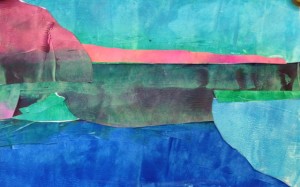
Art
The second and third graders also learned about Henri Matisse this week. We read a book called “Drawing with Scissors” and we looked at several examples of Matisse’s paintings and collages. The students started a collage of a still life with a window in the background. They’re practicing cutting out shapes without drawing first!
Music
This week we discussed the brass section of the orchestra, and listened to The William Tell Overture, both as theme music of the 1949 Lone Ranger TV show and as conducted by Gustavo Dudamel.
by Sarah Segall | Mar 26, 2016 | In The Loop
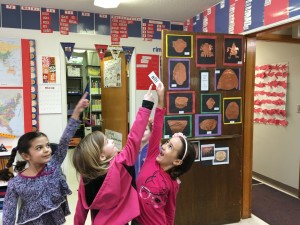 Language Arts
Language Arts
In language arts we read Los bomberos/The Firefighters.
In writing this week the students finished their friendly letters. We learned about how to write a summary/resumen using our story about the fire fighters as an example. We discussed that when writing a summary we must first tell what we are going to write about and then talk about what you just introduced, but with more details. We also used a graphic organizer to help visualize the order in which the story took place. They used words that indicated the order of the story that they also used in their friendly letters such as primero/first, después/next, luego/later and por ultimo/finally. We also watched a video about a little boy named Pedro that with the help of his friends, set out to find a treasure. The kids did a great job summarizing this story as well!
Math
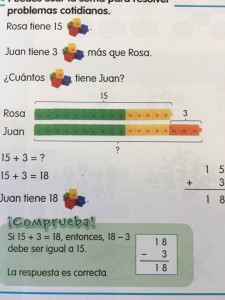 This week in math we continued working on addition and subtraction with regrouping. The kiddos are starting to get the hang of it. I am so proud of their hard work! Ask your child if he or she can remember our new regrouping poem. We had lots of fun practicing it with some cool moves!
This week in math we continued working on addition and subtraction with regrouping. The kiddos are starting to get the hang of it. I am so proud of their hard work! Ask your child if he or she can remember our new regrouping poem. We had lots of fun practicing it with some cool moves!
We also began our section on the addition of 3 single digits with the help of number bonds and the “making 10 strategy”. For example: 3+9+7=19, if we use the “making 10 strategy” we would add the 3+7 first which equals 10 and then add the 9 which equals 19. We reviewed how it’s always much easier to add a number to 10.
We also worked on word problems with addition and subtraction. We used connecting cubes and diagrams to help us solve problems with and without regrouping. The kiddos then checked to make sure their answers were correct by either adding or subtracting.
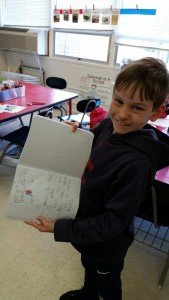 History & Geography
History & Geography
We started the week off by reviewing the Boston Tea Party and how a blockade in the Harbor could have such an impact on the colony of Massachusetts. We didn’t read about the shot that was heard around the world and Paul Revere’s famous ride. We watched a Schoolhouse Rocks video on the Boston Tea Party as well. This week we added to our class timeline and we practiced our colonies chant and the song Yankee Doodle Dandy. We read a trade book that had Paul Revere’s Ride poem in it. On Thursday we read about the Declaration of Independence we looked at a copy of the independence and we watched a short film about the signing of it.
Science
In science this week we finished our lesson on the Space Race between the Soviet Union and the United States. 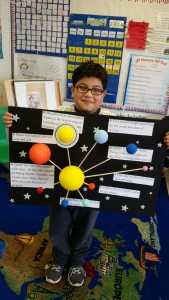 We read about the exploration of the Moon and we wrote in our journals about what it’d be like to land on the moon. We also watched a short clip of the landing of Apollo 11. We read several trade books that were both nonfiction and fiction about the moon and we discussed the differences between the two.
We read about the exploration of the Moon and we wrote in our journals about what it’d be like to land on the moon. We also watched a short clip of the landing of Apollo 11. We read several trade books that were both nonfiction and fiction about the moon and we discussed the differences between the two.
English Spelling
This week we got our new sorts, which are looking at long and short i sounds. We reviewed how the e at the end of words makes the i say its name. The class was responsible for two activities this week, many did rainbow words while others chose pyramid words or writing them out 3 times. We also played hang man to practice spelling and recognizing patterns. I met with individual students to help work on certain aspects of the sort. The spelling test will be next Friday, April 1st. For grammar this week we talked about contractions and other places that we see apostrophes in words. We also played some games with our Zoo phonics.
 Art
Art
The first graders continued their Matisse project this week in art. They cut out fruit, vases, and flowers for the still life, and then they worked on making a landscape in the window. They still need to put a few finishing touches on these fun collages.
Music
The class watched YouTube videos of several several songs from Rogers and Hammerstein’s “The King and I,” including “The a March of the Siamese Children” and “Getting to Know You.”
by Sarah Segall | Mar 18, 2016 | Preschool
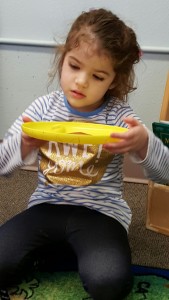 El sistema solar
El sistema solar
This week we continued working with the solar system. The kids learned how the planets orbit the sun with a fun activity. This gave the kiddos a hands-on hand, concrete, way to understand how planets orbit the sun in a large circle. We rolled a ball of orange playdough and stuck it in the middle of the circle plate to represent the sun. We put a blue balloon to represent the earth, and we made the earth orbit around the sun. The kids enjoyed doing this project. As well, we worked with constellations. With this project the kids used their imagination doing different shapes that they saw in the night sky.
Letras y Números
We incorporated our touch investigation with the letter/letra Gg. The kids practiced handwriting, we sang songs,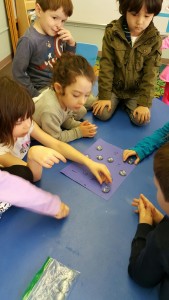 read a book of the letter Gg, and recognized the letter in our daily reading. The English letter name Gg, can be pronounced(lli). While the Spanish letter name pronunciation is (ge). The hard pronunciation of this letter is the same in English and Spanish. (The hard sounds occurs in all instances when it is not followed by i or e, which is the same rule in English and Spanish.)
read a book of the letter Gg, and recognized the letter in our daily reading. The English letter name Gg, can be pronounced(lli). While the Spanish letter name pronunciation is (ge). The hard pronunciation of this letter is the same in English and Spanish. (The hard sounds occurs in all instances when it is not followed by i or e, which is the same rule in English and Spanish.)
Words we worked with this week were:
gorra/hat
gato/cat
gorila/gorilla
gusano/worm.
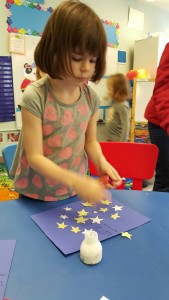 This week we worked with the number 15, counting falling stars and counting one-to-one correspondence and recognition.
This week we worked with the number 15, counting falling stars and counting one-to-one correspondence and recognition.Counting things at home or when you are out and about is very important.
Be sure to only say the number as the item is touched or placed.
by Sarah Segall | Mar 18, 2016 | In The Loop
Language Arts
This week we worked on:
- Community circle and sharing time
- New spelling list, palabras con j y g
- Writing: Writing a Summary
- Writing assessment: Writing a Summary (two sessions)
- Spelling sentences
- Independent reading time
- Saint Patrick’s day procedural writing fun: How to Construct a Leprechaun’s Trap
- Hands-on project: Building Leprechaun’s Trap
- Guest speaker: Ale visiting from Mexico (ask your child to tell you more about our wonderful visitor with whom they were able to use their Spanish in the most authentic way yet!)
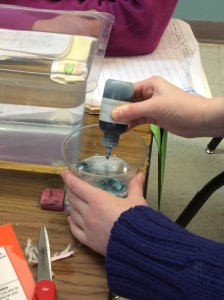 Science
Science
Continuing with our investigation 4, Aquatics Environments, we dove deeper into finding the effect that carbon dioxide produces in the water and fish. We discussed how living organisms affect the quality of aquatic environments. This week’s investigation consisted of finding the acidity levels of the water in our aquariums by putting a couple drops of BTB or Bromothymol blue (innocuous chemical to test water). They took samples of clean water, and water containing different organisms. After putting BTB in the water, students observed how the water changed colors, depending on the acidity levels: blue: no acidity, green:little acidity, yellow: significant acidity. After taking some other samples and blowing air though a straw into a cup (ask your child!) we concluded: both fish and humans exhale a gas called carbon dioxide (CO2). The carbon dioxide combines with water to form carbonic acid. Goldfish 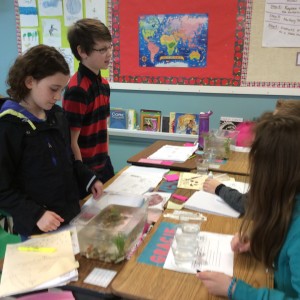 cannot tolerate high levels of carbon dioxide for long periods of time.
cannot tolerate high levels of carbon dioxide for long periods of time.
One of our science objectives during our investigation:
- Students will be able to use the scientific thinking process to conduct investigations and build explanations: observing, communicating, comparing, organizing, relating, documenting, classifying and categorizing.
Math
We finished our chapter on pre-algebra this week and took a final chapter test to show our mastery. This was a fun chapter for myself and I believe the students enjoyed it as well. It was a rare time that we did things whole group during math. I had a good time interacting with the whole class at once on these various concepts. The students all took to it with rigor! Next week we will start discussing the area of triangles. At the end of this week your student should be able to:
-exhibit mastery in pre-algebra in writing, simplifying, evaluating and comparing the values of algebraic expressions as well as solving equations.
History & Geography
This week we did various map activities in and around the activities of the historical Westward Expansion of our country. We also took a deeper look into the importance of Daniel Boone. Next week we will pick apart some other integral historical figures of this time that we’ve only just briefly read about thus far in the unit. At the end of this week your student should be able to:
– read and interpret a map featuring the westward expansion of the United States
– read and interpret a U.S. Map featuring cattle drive and railroad routes
– interpret a U.S. map featuring rivers, mountains, and other important physical features
– read and interpret a U.S. map featuring the route of the Lewis and Clark expedition
– read a map featuring rivers, mountains, and other important physical features of the United States
– explain why Daniel Boone was important the the settling of the west
– state five facts about Daniel Boone
– describe the route discovered by Daniel Boone and explain its importance to westward expansion in an oral discussion as well as tracing it
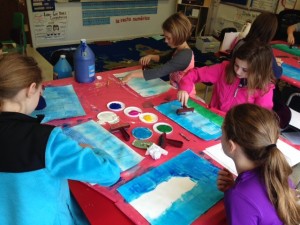 Art
Art
In 4th/5th grade art, we started a landscape project to go along with their westward expansion social studies unit. We spent the entire time making lots of “painted paper” using tempera paint and printmaking rollers. The students had fun experimenting with various colors and textures! Next week they’ll use these painted papers to create a landscape collage.
Music
We celebrated St. Patrick with Sr. Kit’s Peruvian harp, on which he played a variety of traditional Celtic as well as Latin American pieces. We also talked about Andean harp traditions stretching from Chile to Venezuela.
by Sarah Segall | Mar 18, 2016 | In The Loop
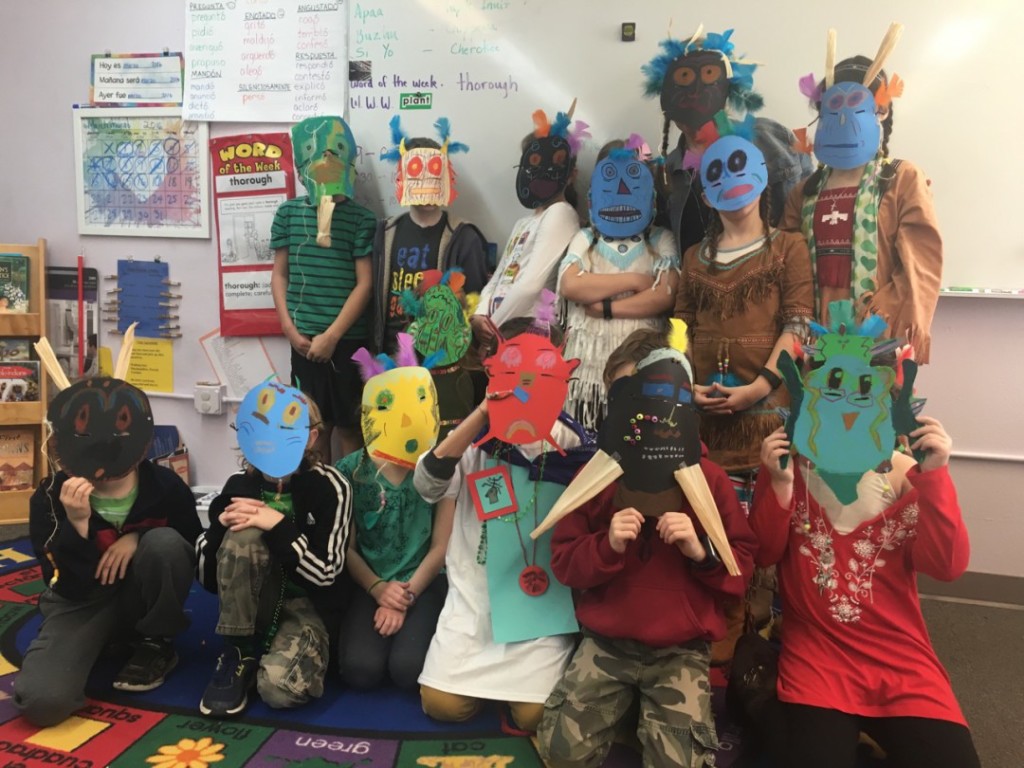
Language Arts
This week we learned all about words of time and order and how they help the reader (or listener) follow the sequence of a story. The students looked through the story they have been writing and made note of any words of time and order. They then worked on adding more of these words to help their writing piece flow.
Another grammar piece for the week was -mente which is equivalent to the -ly suffix. We talked about how this makes and adverb and adverbs are descriptive words for verbs. (Like adjectives describe nouns.) We did a great section in our Estudio de palabra journals and learned how these adverbs are formed.
The students all did a great job on their weekly spelling tests and their sentences reflected their understanding of the meanings and uses of these words. They also did a great job on their readers (book #18) and their word work for this book.
Math
This week we completed our fractions unit. The students had fun with our game style review and then did very well on their assessments.
Students should now be able to:
- understand a fraction as the quantity formed by parts out of a whole.
- understand a fraction as a number on the number line.
- explain the equivalence of fractions in special cases, and compare fractions by reasoning about their size.
- understand tow fractions as equivalent if they are the same size, or the same point on a number line.
- recognize and generate simple equivalent fractions.
- explain why specific fractions are equivalent.
- express whole numbers as fractions, and recognize fractions that are equivalent to whole numbers.
- compare two fractions with the same numerator or the same denominator by reasoning about their size.
- recognize that comparisons are valid only when two fractions refer to the same whole.
 Social Studies
Social Studies
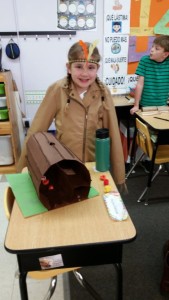 We began this week by working on our tic-tac-toe project in class. Students had the chance to get on the computers and do research on different aspects of their project or to type parts of it out. We also spent some time trying to finish up our read aloud chapter book, Children of the Longhouse. The class loves to predict what’s going to happen next in the story and they get very upset when I end on a cliffhanger, which I do often. Better to leave them wanting more. Our Native American day on Thursday was amazing! I hope everyone had as much fun as I did. We began the day by doing a tour of all of the dwelling models that students made. The Kindergartners and first-graders also got a chance to come in and see the class’s work. The 2nd/3rd graders explained to the visitors what their models were and how they built them. We then watched a slideshow with different Native American masks and then made our own Iroquois Shaman masks. After this we had a Northwest Native American Potlatch, enjoying some food that the Native Americans might have eaten as well as corn recipes that some of the students made at home. Everything was delicious! We ended our day sitting around the school’s teepee and using a traditional Talking Stick, (thank you Lily) to share things that we were thankful for. I was very impressed at how much time and effort everyone put into their projects, they should be very proud of themselves.
We began this week by working on our tic-tac-toe project in class. Students had the chance to get on the computers and do research on different aspects of their project or to type parts of it out. We also spent some time trying to finish up our read aloud chapter book, Children of the Longhouse. The class loves to predict what’s going to happen next in the story and they get very upset when I end on a cliffhanger, which I do often. Better to leave them wanting more. Our Native American day on Thursday was amazing! I hope everyone had as much fun as I did. We began the day by doing a tour of all of the dwelling models that students made. The Kindergartners and first-graders also got a chance to come in and see the class’s work. The 2nd/3rd graders explained to the visitors what their models were and how they built them. We then watched a slideshow with different Native American masks and then made our own Iroquois Shaman masks. After this we had a Northwest Native American Potlatch, enjoying some food that the Native Americans might have eaten as well as corn recipes that some of the students made at home. Everything was delicious! We ended our day sitting around the school’s teepee and using a traditional Talking Stick, (thank you Lily) to share things that we were thankful for. I was very impressed at how much time and effort everyone put into their projects, they should be very proud of themselves.
Science
This week we did a lesson review on how to write biographies. We then focused on Nicolaus Copernicus, we brainstorm facts that we know about him and a web with these. We will do more with this next week when we write a biography about him together as a class. On Tuesday we started a lesson on space exploration the class learned about the space race between the USSR and the United States. We talked about Sputnik and the first living beings that went into space. Are space lessons always take us more time then I plan for because our conversations are so full of questions, observations , and information that students have to contribute to what we are learning.
English Spelling/Writing
We had our usual routine in spelling this week. Students worked on their sorts and activities. Next week I’m going to change things up just a little bit and require that students do different activities than they did the previous week. Hopefully this will get them thinking in different ways about their sorts. In general most of the class did well on their spelling test. For grammar we reviewed suffix ly ; we talked about how this suffix can change a noun to an adjective and an adjective into an adverb.
Some of our journal entries this week included writing about something courageous you have done and about a person you might want to write a biography about, stating what you know already about them and what you would need to find out.
Art
The second and third graders finished their coil pottery this week. They painted one of their pots with acrylic paint, and made a third coil pot using coils on all sides. These colorful pots were on display in the classroom for the Native American festival, and hopefully they made it home safely!
Music
We celebrated St. Patrick’s day with Sr. Kit’s Peruvian harp. He played traditional Celtic and Latin American pieces and talked about the harp traditions in Peru and Ecuador.
by Sarah Segall | Mar 18, 2016 | In The Loop
Language Arts
This week we began doing calendar time differently than we have done in the past. Previously the kiddos verbally expressed the date and added and subtracted the number of the day but now they were given the opportunity to incorporate all the calendar skills in written form. This included: the date, the word of the day/palabra del día, the number of the day/número del día and math. In the math portion we added and subtracted 5 and 10 to the number of the day and expressed the number of the day in expanded form /forma desarollada, word form/forma de palabras and in tallies/cuentas. Finally, we expressed the number in the form of dollars and cents. Number bonds with addition and subtraction of the related number families were also part of the activity. You should have seen a couple of these activity sheets in your child’s take home folder.
In writing this week we continued to work on our friendly letters. The kids edited their rough drafts and continued to add interesting details. We emphasized the editing process discussing how at times we must write and rewrite a letter or story several times before it is ready for publishing.
Math
In math this week we continued working on subtraction with regrouping. We discussed and practiced how a number is transformed when we regroup, though the value doesn’t change. For example 1 ten is the same as 10 ones. We practiced regrouping using our base 10 rods and our unit cubes along with our place value tables which helped the children to better visualize the regrouping process.
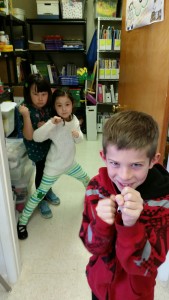 Social Studies & Science
Social Studies & Science
This week we have begun our new unit in the birth of our nation curriculum. We started the week off by reading and reviewing how Europeans first came to the New World. It was a great opportunity for students to review what they learned last year about the pilgrims and Columbus. We began a class time line so that we have a visual reminder of what we are learning and we learned the 13 colonies chant. We had some wonderful discussions about indentured servants and slaves in the New World . The class was very passionate about how they felt on the subject of slavery. On Thursday we read about the Boston Tea Party and had our own reenactment in class. Some student’s played the role of Sons of Liberty, others were store merchants, and then we also had our British soldiers. After we had the tea dumping and the closing down of the Boston Harbor we then discussed who wanted to be Patriots and who were Loyalists. We held a Continental Congress meeting with representatives from the colonies and we drafted an imaginary letter to the King of England. Benjamin Franklin pretended to write this letter out (Ben played this role).
The class loved doing this exercise and learned a lot.
Science
We’ve been reading big books about space this week. We started a class book about what we have 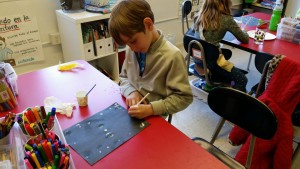 learned so far in our solar system unit and will be finishing that up next week. We had fun playing a stargazers vs astronomer game as review. On Thursday the class began a lesson on history of space exploration. We learned a little about the Space race between the Soviet Union and the United States, and they read about Sputnik. The class was amazed to learn that this first satelite was the size of a beach ball. We will continue this lesson next week.
learned so far in our solar system unit and will be finishing that up next week. We had fun playing a stargazers vs astronomer game as review. On Thursday the class began a lesson on history of space exploration. We learned a little about the Space race between the Soviet Union and the United States, and they read about Sputnik. The class was amazed to learn that this first satelite was the size of a beach ball. We will continue this lesson next week.
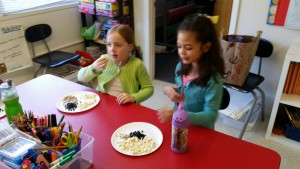 English Spelling
English Spelling
We worked on finishing up our sort activities and studying for spelling test this week. Students have been working with a partner to practice their words. The class had their spelling test on Thursday and did great! For grammar we reviewed punctuation, focusing on when and why we use periods. In journal writing, the class wrote a short story about their Inca masks. The students had a choice on Tuesday to either write about what it would be like to be a Native American already living in North America when the pilgrims arrived or a sailor traveling with Columbus on one of his ships when he landed in the Bahamas. On Thursday they wrote an entry about St. Patrick’s day.
Art
The first graders learned about Henri Matisse this week. We read a book called “Drawing with Scissors” and we looked at several examples of Matisse’s paintings and collages. The students started a collage of a still life with a window in the background. They’re practicing cutting out shapes without drawing first!
Music
Sr Kit brought his Peruvian harp today. He played a number of traditional pieces from Ireland and Latin America, with the class accompanying on the rhythm instruments.
by Sarah Segall | Mar 18, 2016 | In The Loop
Language Arts
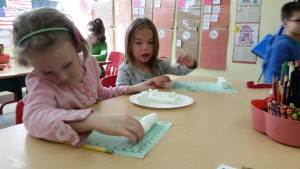
Measuring lines with small and big marshmallows.
We read a great book to go along with our Rojo, Blanco, y Azul theme. The book we read was “El regalo de Li”. This is a story of the naturalization process in the United States. Li Fong, a young Chinese boy, has two very important issues on his mind: becoming a citizen of the United States and losing his first tooth. In his young mind, the two are intertwined- he seems to think that the Tooth Fairy won’t visit him until he’s a citizen. This provided us the great opportunity to talk about how one becomes a citizen. We all agreed that being born here seems to be the easiest way!
This week we also worked a lot with different types of sentences and how we can extend our sentences by giving just a little more information. We also had a discussion about how we stay on topic when writing. We showed several books and asked what we could expect to learn about, always being sure they stayed on the same topic.
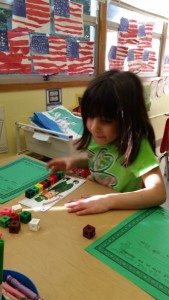
Measuring leprechaun height with cubes and paper clips.
Math
We incorporated our money skills into our morning binder work. Now students use coins to form each new number of the day. They are pretty comfortable using either 4 quarters or 10 dimes to form the 100. Then they just add on dimes, nickles, and pennies from there.
We had a lot of fun using our measuring and comparing skills for Saint Patrick’s Day activities.
Social Studies & Science
This week we started our unit on “Farms”. We will be focusing on animals and their needs. On Monday we brainstormed things and animals you can find on a farm. We learned about the many jobs a farmer has. We learned that most of the food we eat at some point came from a farm. We learned about the buildings and machines on farms. We had fun making finger puppets of farm animals and we used them to help us to sing “Old Mac Donald”. Hopefully your student shared these with you at home.
On Tuesday we learned about cows and calves and their needs: food, water, and space to live and grow. We learned that baby animals need to be fed and cared for by their parents or people. We started our own class book of “Old Mac Donald” with a twist! Just wait til this comes home for a visit! We also reviewed the landforms that we are learning about by creating them out of playdough.
Lastly, on Thursday, we learned about chickens, hens and roosters. See if your kiddo can identify the needs of a chicken. We also explained whyu farmers raise chickens and the foods that come from chickens.
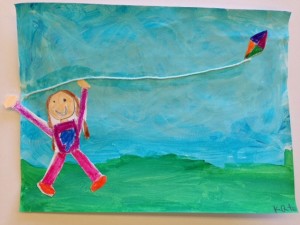 Art
Art
In Kindergarten art, the students finished their “Windy Day” pictures. They added a few more swirly lines to the sky, and then we reviewed using basic shapes to draw a person. The students also learned how to draw a kite shape. The students glued all these parts together to make great windy day art!
Music
We talked about folk music traditions around the world, and especially the use of he harp in Ireland.
by Sarah Segall | Mar 12, 2016 | Preschool
El sistema solar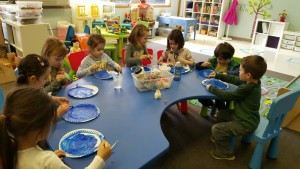
We created our own full moons. We also looked at the phases of the moon, and talked about the different images we see in the moon. We saw rabbits and faces. We also talked about why the moon glows at night. (It’s because of the sun.)
This was a simple and fun project, because the kids loved watching the marker bleed on the paper with just a few drops from the eye dropper.
We had fun singing moon songs and playing “una luna, dos lunas” (very much like “one potato, two 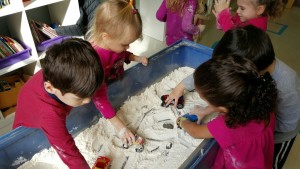 potatoes”.
potatoes”.
We looked at photographs of the moon that showed the surface. The kiddos pointed out the colors and craters they saw. We then had a blast making our own model of a trip to the moon.
We made our own space rockets where we imagined taking a trip to space. We used dirrection words: arriba / above, abajo /below , sobre / over, etc. At the same time we talked about space ships and their functions.
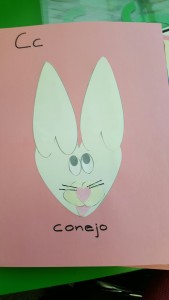 Las letras y los números
Las letras y los números
We learned all about the letter C this week by singing songs, reading the C book, and playing games. We also practiced writing this letter by first tracing with our finger and then with markers. This letter is just like the English letter C. It makes the soft /s/ sound when followed by i or e. (Think: city, center.) It makes the hard /k/ sound at all other times. Some of the specific words we worked with this week were:
casa/house,
conejo/rabbit
camion/bus
corona/ crown
cebra/zebra
concha/seashell
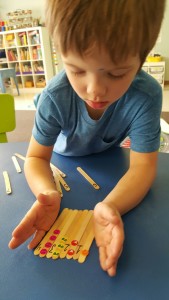 This week we continued working with number 14 as a review, we used fun and simple activities to help the kiddos build and consolidate their understanding of identifying the number and how it is represented using popsicle sticks and stickers.
This week we continued working with number 14 as a review, we used fun and simple activities to help the kiddos build and consolidate their understanding of identifying the number and how it is represented using popsicle sticks and stickers.
Identifying the numbers and putting them in correct order is a big skill!
 Our theme this week was Las flores, and thanks to Connor and his beautiful family, the ending of the week could have not been more perfect. Thank you!. Please make sure you stop by and see our beautiful bulletin board. Students worked really hard on the spelling and vocabulary project of the song Las flores. Also, in connection to math (lines, segments, angles, triangles, etc.), students created wonderful art pieces!
Our theme this week was Las flores, and thanks to Connor and his beautiful family, the ending of the week could have not been more perfect. Thank you!. Please make sure you stop by and see our beautiful bulletin board. Students worked really hard on the spelling and vocabulary project of the song Las flores. Also, in connection to math (lines, segments, angles, triangles, etc.), students created wonderful art pieces! Science / ciencia
Science / ciencia History & Geography
History & Geography Math
Math






























